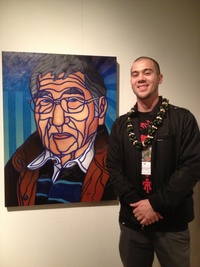“When you walked into (my grandfather’s) house, you saw his paintings hanging like a gallery, you saw stained glass windows he created, you saw wood tables he built and you just smelled art,” says artist Timothy Teruo Watters.
From an early age, Watters was inspired by the artistic passion of his maternal grandfather and namesake, the late artist Teruo Iyama. It was Iyama who bought Watters his first blank canvas.
“I definitely don’t think it has been that long, but when I look back, it is crazy to say I have been painting seriously for over 17 years at the ripe old age of 31,” says Watters. “Before I started painting, I was always sketching, drawing and imagining. So when (I began painting), it felt like a natural extension of my previous work. Within a short year, I had already developed my style almost by accident.”
Best known for his striking, stained-glass style portraiture of cultural icons such as rappers Snoop Dogg, Tupac Shakur, and Ice Cube, boxer Manny Pacquiao, and basketball legend Kobe Bryant, Watters has acquired an impressive following of fans—and art collectors. His distinctive style has become immediately recognizable to art audiences.
Watters took art classes at the University of California, Santa Barbara, but he is largely self-taught. Yet he humbly credits his grandfather’s influences for helping him to find his own creative path.
“My grandfather was an American but a traditional Japanese man—he spoke very little and let his actions do the talking,” says Watters. “He was self-taught and constantly challenged himself from carpentry to stained glass to gardening to oil painting to sewing. When you walked up to his house you saw his beautiful gardens clinging to the hillside he cleared himself. He was a master of the simple and color balance. His impressionistic art captured everyday life with an air of serenity. I have always revered the impressionist way of art and have tried to carry on that tradition but in my own way.”
“My grandfather’s earlier work was outlined, and I have always loved the emphasis an outline brings,” Watters explains. “So back in ’97, my outlined style was born which many have called the stained glass style. And ever since then, I have been refining it, simplifying it and trying to make it more powerful. I love the simple—the lowest common denominator; I just use a paint brush, oil paints and a canvas.”
“I am truly blessed to have a very supportive family,” says Watters. “While my parents have always snuck in some comments, they have always been there for me and have helped me in every way possible. You cannot do it alone and I would not be here if it were not for my family. Of course, I still went to college and got a degree in Business-Economics (just in case—thanks Mom and Dad).”
Watters says his family heritage has shaped his views in other ways. “Being biracial gives me a different perspective on life. With two separate families, I have grown up seeing life in two different ways. I approach problems and ideas by looking at them from multiple angles; my creative process reflects this perspective.”
“I often look at dualities (nature vs. urban, old vs. new, black vs. white) and am very interested in bringing different themes under the same umbrella,” says Watters. “As a chemical engineer, my paternal grandfather worked on the Manhattan project and literally moved the uranium for the atomic bomb, while my maternal grandparents were interned at the Japanese concentration camps (where my mother was born) of the very same World War II. The world is a small place with crazy connections if you care to seek them out.”
That small world has become even smaller through Watters’ art—and the relationships with famous people that his art has catalyzed.
“If someone would have told me 10 years ago that I would have collectors from Kobe Bryant to Damian Marley to Ice Cube to Chris Cornell, I would have shook my head saying, ‘Yeah right,’” says Watters. “It has been a privilege and blessing to be able to meet some of the artists that I (honor, through portraits) for their crafts, be it basketball or music or community work.”
“One of my favorite experiences was meeting [Jamaican reggae artist] Damian Marley and [American rapper] Nas while they were on tour for their dope album Distant Relatives,” Watters recalls. “I had unveiled the Marley piece first and Damian just looked at me with a quiet approval and smile. Nas was in the background asking where his was, and when he saw it, he was blown away. I know it is hard to impress these big stars because they have seen so much and lived a lot. Receiving acknowledgement from artists like Nas and Damian Marley is a blessed feeling and one I cherish. Game recognize game.”
While still relatively young, Watters is thoughtful about the career he has enjoyed so far, and about the generation of budding artists that is soon to follow him. “My only advice for younger artists is simply to go for it. Like most things in life, if you are timid, you are not really going anywhere. I spun my wheels for a while learning this lesson. If you are going to paint, then paint. Do not be afraid to throw paint up there, do not be afraid to try something new, do not be afraid to fail. If you are not making unsuccessful art, then you are not really making successful art.”
“It is impossible to please everyone, especially when it comes to the subjective, like art,” Watters notes. “I had this ‘fan’ who used to post negative comments on all my YouTube videos about whether if I really sketched out the painting or if I did my own work or if that the portrait ‘almost’ looked like the person I was painting. He eventually left a comment that my art was simply ‘paint by number.’ At the end of the day, your art has to be what represents you. I do not expect everyone to get me, to understand me or to like me. As long as you are proud of your hard work and creations, no one can take that away.”
Watters says that Teruo Iyama exemplified that philosophy. “When my grandfather passed, he had literally hundreds and hundreds of paintings that no one ever saw—he painted for himself. I am running the same race he ran long ago, hoping one day I will measure up to his creativity.”
* * * * *
Supernatural: The Art of Audrey Kawasaki, Edwin Ushiro, and Timothy Teruo Watters
February 9 – March 17, 2013
Japanese American National Museum
Los Angeles, California
Traditions are an integral part of every community. Some of these come from superstitions that our ancestors carried with them.
Supernatural features the work of Audrey Kawasaki, Edwin Ushiro, and Timothy Teruo Watters—artists who have explored some of these otherworldly concepts, illustrating how traditional ideas have evolved and been adapted over time.
For more information about the exhibition >>
© 2013 Darryl Mori








